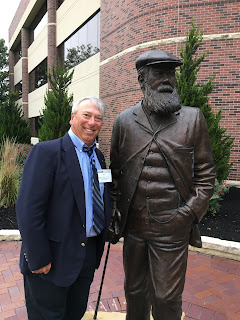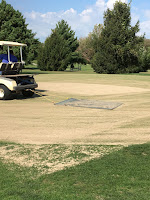It is our old Rain Bird 51 DR hold up tool that we use when we are working on our old Rain Bird heads. It unfortunately has been run over a couple times with a cart I believe. Rain Bird themselves and some other sources did not have them, which I don't blame them, these heads were old technology when they were installed in 1993.
I also posted this on our Golf Course Superintendents Association of America (GCSAA) member forum. That is where I heard from a retired superintendent who thought his old course just might have these tools.
This is what arrived today, a set of tools that should work just fine for our old irrigation heads.
I will certainly look forward to getting these out to the golf course to help us with our fall irrigation head repairs. I can't express enough my appreciation for these.
Of course this is nothing new in our industry. I remember long ago when we were aerating greens one year at our course in New Jersey, we had our aerator break down. With in an hour, we were back to punching holes after a near-by course had brought theirs over to our place. I even heard talk of sharing equipment recently at our September Scholarship and Research fundraiser. (Fundraising and golf should be a good topic for another blog over the slow winter time.)
Yes I mentioned meetings where we will get together and play some golf, but while we do that we also talk about what we are doing at our courses, often comparing notes and ideas. I couldn't tell how many times I have gotten ideas from colleagues to take back to my course and try and provide a better product for my golfers. It amazes me sometimes how we are so ready to help our fellow superintendents who are at courses that we actually compete for customers.
Even at a recent Chapter Delegates meeting at our GCSAA national headquarters in Lawrence, while talking about issues that affect our local chapters and members, whenever we had breaks, or on the bus ride back to the hotel, there we were discussing our part of the business of golf. It didn't matter if we were from different parts of the country, growing different grasses, we were finding common ideas. Even discussing personnel issues, such as how the new Overtime law would effect our different facilities.
And now to mention the best most recent tool when it comes to sharing information. It is social media of course! Blogs from people much smarter than myself, Facebook groups, and even Twitter as the posts below show a couple of ideas I have learned from. And by the way great people to follow.
Chris was a great follow leading up to and during the Ryder Cup. He shared many of their practices, allowing us to pick and choose what might work for us, and also allowing us to promote new ideas to our stake holders at our courses. It is amazing how if I promote a new idea, practice, product to my bosses, how easily I can sell it when I can say they do it at "so and so club"
It would be great to hear from others the success stories you have been able to achieve from help you have received from our peers. Would love to hear about how other golf industry professionals, such as pros and managers of stories they have of helping one another.
I am so glad to be part of this great industry.
Thanks for reading!
Mel













